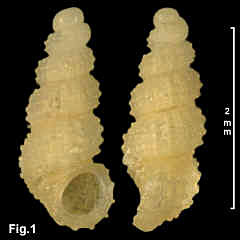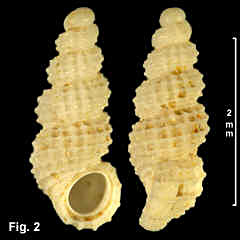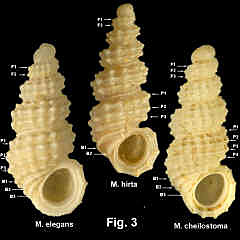|
|
RISSOIDAE |
|
|
|
Merelina cheilostoma (Tension-Woods, 1877) Description: Shell elongate, spire weakly convex. Protoconch of 1¼ whorls bearing strong nodulose spiral threads, with distinct junction with teleoconch. Teleoconch up to 5½ rounded whorls. Whorls sculptured with spiral cords, 3 on first whorl increasing to 4 on second-last whorl, with axial ribs varying from weaker to stronger than spirals, forming weak beads at intersections; base of last whorl with 3 additional ribs - the first beaded or smooth, the lower 2 unbeaded. Aperture ovate, with neither anterior nor posterior canal; outer lip with strong varix externally. Umbilicus closed. Shell colourless or fawn translucent when fresh, becoming opaque with age. Size: Up to 4.0 mm in length, adults 2.5 - 4.0 mm. Distribution: Endemic to Australia: Cape Moreton, Queensland, southwards and around southern Australia, to eastern Great Australian Bight, including Tasmania. Habitat: Empty shells are known from beach washup and down to 183 m. Uncommon. Comparison: A comparison of Merelina elegans, M. hirta and M. cheilostoma is shown in Fig. 3. The species can be distinguished by the spiral rib counts on the first whorl, second-last whorl, and also on the base, as follows: M. elegans: 2 ribs on first whorl (F1, F2), 3 ribs on second-last whorl (P1, P2, P3), 3 ribs on base (B1, B2, B3); M. hirta: 2 ribs on first whorl, 3 ribs on second-last whorl, 2 ribs on base, the upper of which is smooth, tall and thin; M. cheilostoma: 3 ribs on first whorl, 4 ribs on second last whorl, 3 ribs on base. Synonymy: There are no synonyms, but many misidentifications. May (1923), Cotton (1959), and Macpherson & Gabriel (1962) all list the name, but they did not differentiate it from M. elegans, and M. hirta.. Laseron (1950, Fig. 13) used M. cheilostoma for a specimen of M. hirta, and that usage was followed by Iredale & McMichael (1962). Remarks: The geographic distribution and depth range of this species is quite wide. It is an uncommon and mainly subtidal species, only occasionally known from beach washup. The assertion by Jansen (1995, Fig. 118) that it does not occur in NSW is incorrect. Fig. 1: 50 miles SE of Kangaroo island, SA, in 77 m (C.222637) Fig. 2: Glenelg R., Victoria. Fossil, Miocene-Upper Pliocene? (C.222587) Fig. 3: Left: M. elegans Middle: M. hirta Right: M. cheilostoma |
|


